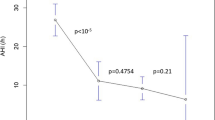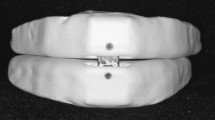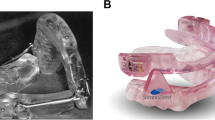Abstract
Objectives
Mandibular advancement device (MAD) therapy is the most commonly used second-line treatment for obstructive sleep apnea (OSA), but MAD may be ineffective in a subgroup of patients. We describe the use of a trial of a titratable thermoplastic MAD to predict treatment outcomes with a custom-made MAD.
Materials and methods
Patients treated with a thermoplastic MAD as a trial before custom-made MAD manufacturing were included in the study. Sleep recordings and clinical outcomes assessed after 6 months of treatment with each device were compared. Predictive utility of thermoplastic MAD to identify custom-made MAD treatment success defined as a reduction greater than 50% and final apnea-hypopnea index (AHI) less than 10 events/h was evaluated.
Results
Thermoplastic MADs were installed in 111 patients, but only 36 patients were finally treated with both devices and were included in the analysis. A significant correlation was observed between the impact of the two devices on the AHI (r=0.85, p<0.0001), oxygen desaturation index (r=0.73, p<0.0001), snoring index (r=0.85, p<0.0001), and Epworth sleepiness scale (r=0.77, p<0.0001). A high positive predictive value (86%) but a low negative predictive value (46%) was observed regarding AHI decrease.
Conclusions
Similar impacts of both MADs were observed on major OSA severity markers and symptoms. The ability of thermoplastic MAD to indicate likelihood of success with custom-made MAD will require further controlled studies.
Clinical relevance
Thermoplastic MADs could represent a useful and easily implemented tool to predict the likelihood of success of a custom-made MAD as treatment for OSA.





Similar content being viewed by others
References
Gagnadoux F, Fleury B, Vielle B, Petelle B, Meslier N, N'Guyen XL, Trzepizur W, Racineux JL (2009) Titrated mandibular advancement versus positive airway pressure for sleep apnoea. Eur Respir J 34:914–920. https://doi.org/10.1183/09031936.00148208
Phillips CL, Grunstein RR, Darendeliler MA, Mihailidou AS, Srinivasan VK, Yee BJ, Marks GB, Cistulli PA (2013) Health outcomes of continuous positive airway pressure versus oral appliance treatment for obstructive sleep apnea: a randomized controlled trial. Am J Respir Crit Care Med 187:879–887. https://doi.org/10.1164/rccm.201212-2223OC
Schwartz M, Acosta L, Hung Y-L, Padilla M, Enciso R (2018) Effects of CPAP and mandibular advancement device treatment in obstructive sleep apnea patients: a systematic review and meta-analysis. Sleep Breath 22:555–568. https://doi.org/10.1007/s11325-017-1590-6
Sutherland K, Vanderveken OM, Tsuda H, Marklund M, Gagnadoux F, Kushida CA, Cistulli PA (2014) Oral appliance treatment for obstructive sleep apnea: an update. J Clin Sleep Med 10:215–227. https://doi.org/10.5664/jcsm.3460
Tsuiki S, Ito E, Isono S, Ryan CF, Komada Y, Matsuura M, Inoue Y (2013) Oropharyngeal crowding and obesity as predictors of oral appliance treatment response to moderate obstructive sleep apnea. Chest 144:558–563. https://doi.org/10.1378/chest.12-2609
Okuno K, Pliska BT, Hamoda M, Lowe AA, Almeida FR (2016) Prediction of oral appliance treatment outcomes in obstructive sleep apnea: a systematic review. Sleep Med Rev 30:25–33. https://doi.org/10.1016/j.smrv.2015.11.007
Gagnadoux F, Nguyen X-L, Le Vaillant M et al (2017) Comparison of titrable thermoplastic versus custom-made mandibular advancement device for the treatment of obstructive sleep apnoea. Respir Med 131:35–42. https://doi.org/10.1016/j.rmed.2017.08.004
Pépin JL, Raymond N, Lacaze O, Aisenberg N, Forcioli J, Bonte E, Bourdin A, Launois S, Tamisier R, Molinari N (2019) Heat-moulded versus custom-made mandibular advancement devices for obstructive sleep apnoea: a randomised non-inferiority trial. Thorax 74:667–674. https://doi.org/10.1136/thoraxjnl-2018-212726
Gagnadoux F, Le Vaillant M, Goupil F et al (2011) Influence of marital status and employment status on long-term adherence with continuous positive airway pressure in sleep apnea patients. PloS One 6:e22503. https://doi.org/10.1371/journal.pone.0022503
Johns MW (1991) A new method for measuring daytime sleepiness: the Epworth sleepiness scale. Sleep 14:540–545. https://doi.org/10.1093/sleep/14.6.540
Gagnadoux F, Le Vaillant M, Goupil F et al (2014) Depressive symptoms before and after long-term CPAP therapy in patients with sleep apnea. Chest 145:1025–1031. https://doi.org/10.1378/chest.13-2373
Berry RB, Budhiraja R, Gottlieb DJ, Gozal D, Iber C, Kapur VK, Marcus CL, Mehra R, Parthasarathy S, Quan SF, Redline S, Strohl KP, Davidson Ward SL, Tangredi MM, American Academy of Sleep Medicine (2012) Rules for scoring respiratory events in sleep: update of the 2007 AASM manual for the scoring of sleep and associated events. Deliberations of the Sleep Apnea Definitions Task Force of the American Academy of Sleep Medicine. J Clin Sleep Med 8:597–619. https://doi.org/10.5664/jcsm.2172
Remmers J, Charkhandeh S, Grosse J, Topor Z, Brant R, Santosham P, Bruehlmann S (2013) Remotely controlled mandibular protrusion during sleep predicts therapeutic success with oral appliances in patients with obstructive sleep apnea. Sleep 36:1517–1525, 1525A. https://doi.org/10.5665/sleep.3048
Vena D, Azarbarzin A, Marques M, op de Beeck S, Vanderveken OM, Edwards BA, Calianese N, Hess LB, Radmand R, Hamilton GS, Joosten SA, Taranto-Montemurro L, Kim SW, Verbraecken J, Braem M, White DP, Sands SA, Wellman A (2020) Predicting sleep apnea responses to oral appliance therapy using polysomnographic airflow. Sleep. 43. https://doi.org/10.1093/sleep/zsaa004
Fleury B, Cohen-Levy J, Lacassagne L, et al (2010) [Treatment of obstructive sleep apnea syndrome using a mandibular advancement device]. Rev Mal Respir 27 Suppl 3:S146-156. https://doi.org/10.1016/S0761-8425(10)70020-6
Sutherland K, Takaya H, Qian J, Petocz P, Ng AT, Cistulli PA (2015) Oral appliance treatment response and polysomnographic phenotypes of obstructive sleep apnea. J Clin Sleep Med 11:861–868. https://doi.org/10.5664/jcsm.4934
Ng ATM, Darendeliler MA, Petocz P, Cistulli PA (2012) Cephalometry and prediction of oral appliance treatment outcome. Sleep Breath 16:47–58. https://doi.org/10.1007/s11325-011-0484-2
Shen H-L, Wen Y-W, Chen N-H, Liao Y-F (2012) Craniofacial morphologic predictors of oral appliance outcomes in patients with obstructive sleep apnea. J Am Dent Assoc 1939 143:1209–1217. https://doi.org/10.14219/jada.archive.2012.0066
Sutherland K, Phillips CL, Davies A, Srinivasan VK, Dalci O, Yee BJ, Darendeliler MA, Grunstein RR, Cistulli PA (2014) CPAP pressure for prediction of oral appliance treatment response in obstructive sleep apnea. J Clin Sleep Med 10:943–949. https://doi.org/10.5664/jcsm.4020
Tsuiki S, Kobayashi M, Namba K, Oka Y, Komada Y, Kagimura T, Inoue Y (2010) Optimal positive airway pressure predicts oral appliance response to sleep apnoea. Eur Respir J 35:1098–1105. https://doi.org/10.1183/09031936.00121608
Chan ASL, Lee RWW, Srinivasan VK, Darendeliler MA, Cistulli PA (2011) Use of flow-volume curves to predict oral appliance treatment outcome in obstructive sleep apnea: a prospective validation study. Sleep Breath 15:157–162. https://doi.org/10.1007/s11325-010-0395-7
Vroegop AVMT, Vanderveken OM, Dieltjens M, Wouters K, Saldien V, Braem MJ, van de heyning PH (2013) Sleep endoscopy with simulation bite for prediction of oral appliance treatment outcome. J Sleep Res 22:348–355. https://doi.org/10.1111/jsr.12008
Bosshard V, Masse J-F, Sériès F (2011) Prediction of oral appliance efficiency in patients with apnoea using phrenic nerve stimulation while awake. Thorax 66:220–225. https://doi.org/10.1136/thx.2010.150334
Attali V, Vecchierini M-F, Collet J-M, d'Ortho MP, Goutorbe F, Kerbrat JB, Leger D, Lavergne F, Monaca C, Monteyrol PJ, Morin L, Mullens E, Pigearias B, Martin F, Tordjman F, Khemliche H, Lerousseau L, Meurice JC, Abedipour D, Allard-Redon A, Aranda A, Attali V, Bavozet F, Becu M, Beruben W, Bessard J, Bonafe I, Boukhana M, Chabrol B, Chatte G, Chauvel-Lebret D, Collet JM, Coste O, Dumont N, Durand-Amat S, D'ortho MP, Elbaum JM, de Santerre G, Goutorbes F, Grandjean T, Guyot W, Hammer D, Havasi C, Huet P, Kerbrat JB, Khemliche H, Koltes C, Leger D, Lacassagne L, Laur X, Lerousseau L, Liard O, Loisel C, Longuet M, Mallart A, Martin F, Merle-Beral F, Meurice JC, Mokhtari Z, Monaca C, Monteyrol PJ, Muir JF, Mullens E, Muller D, Paoli C, Petit FX, Pigearias B, Pradines M, Prigent A, Putterman G, Rey M, Samama M, Tamisier R, Tiberge M, Tison C, Tordjman F, Triolet B, Vacher PC, Vecchierini MF, Verain A (2019) Efficacy and tolerability of a custom-made Narval mandibular repositioning device for the treatment of obstructive sleep apnea: ORCADES study 2-year follow-up data. Sleep Med 63:64–74. https://doi.org/10.1016/j.sleep.2019.04.021
Funding
This work was funded by the Institut de Recherche en Santé Respiratoire (IRSR) des Pays de la Loire (9 rue du landreau – BP 77132 – 49071 Beaucouze cedex, France). The content of this manuscript is solely the responsibility of the authors.
Author information
Authors and Affiliations
Corresponding author
Ethics declarations
Ethics approval
All procedures performed in studies involving human participants were in accordance with the ethical standards of the institutional and national research committee and with the 1964 Helsinki declaration and its later amendments or comparable ethical standards. Approval was obtained from the University of Angers Ethics Committee and the “Comité Consultatif sur le Traitement de l’Information en matière de Recherche dans le domaine de la Santé” (07.207bis).
Informed consent
Informed consent was obtained from all individual participants included in the study.
Conflict of Interest
WT and NM report non-financial support from ASTEN. FG reports grants and personal fees from RESMED, personal fees and non-financial support from SEFAM, personal fees from CIDELEC, personal fees and non-financial support from NOVARTIS, personal fees from ACTELION, non-financial support from BOEHRINGER INGELHEIM, personal fees and non-financial support from AIR LIQUIDE SANTE, non-financial support from ASTEN, and personal fees and non-financial support from NYXOAH unrelated to the submitted work.
Additional information
Publisher’s note
Springer Nature remains neutral with regard to jurisdictional claims in published maps and institutional affiliations.
Rights and permissions
About this article
Cite this article
Trzepizur, W., Adrian, B., Le Vaillant, M. et al. Predicting treatment response to mandibular advancement therapy using a titratable thermoplastic device. Clin Oral Invest 25, 5553–5561 (2021). https://doi.org/10.1007/s00784-021-03865-0
Received:
Accepted:
Published:
Issue Date:
DOI: https://doi.org/10.1007/s00784-021-03865-0




